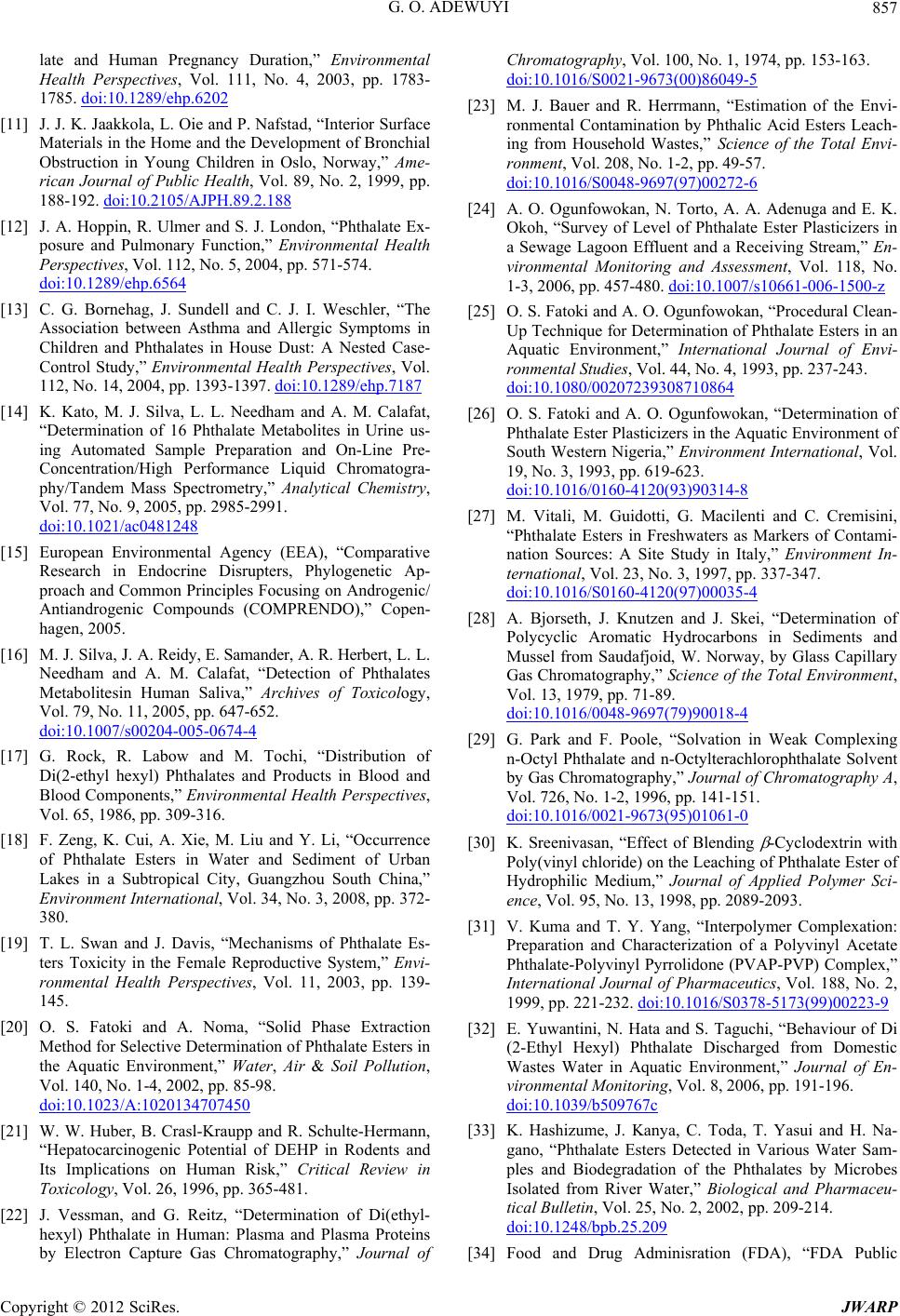
G. O. ADEWUYI 857
late and Human Pregnancy Duration,” Environmental
Health Perspectives, Vol. 111, No. 4, 2003, pp. 1783-
1785. doi:10.1289/ehp.6202
[11] J. J. K. Jaakkola, L. Oie and P. Nafstad, “Interior Surface
Materials in the Home and the Development of Bronchial
Obstruction in Young Children in Oslo, Norway,” Ame-
rican Journal of Public Health, Vol. 89, No. 2, 1999, pp.
188-192. doi:10.2105/AJPH.89.2.188
[12] J. A. Hoppin, R. Ulmer and S. J. London, “Phthalate Ex-
posure and Pulmonary Function,” Environmental Health
Perspectives, Vol. 112, No. 5, 2004, pp. 571-574.
doi:10.1289/ehp.6564
[13] C. G. Bornehag, J. Sundell and C. J. I. Weschler, “The
Association between Asthma and Allergic Symptoms in
Children and Phthalates in House Dust: A Nested Case-
Control Study,” Environmental Health Perspectives, Vol.
112, No. 14, 2004, pp. 1393-1397. doi:10.1289/ehp.7187
[14] K. Kato, M. J. Silva, L. L. Needham and A. M. Calafat,
“Determination of 16 Phthalate Metabolites in Urine us-
ing Automated Sample Preparation and On-Line Pre-
Concentration/High Performance Liquid Chromatogra-
phy/Tandem Mass Spectrometry,” Analytical Chemistry,
Vol. 77, No. 9, 2005, pp. 2985-2991.
doi:10.1021/ac0481248
[15] European Environmental Agency (EEA), “Comparative
Research in Endocrine Disrupters, Phylogenetic Ap-
proach and Common Principles Focusing on Androgenic/
Antiandrogenic Compounds (COMPRENDO),” Copen-
hagen, 2005.
[16] M. J. Silva, J. A. Reidy, E. Samander, A. R. Herbert, L. L.
Needham and A. M. Calafat, “Detection of Phthalates
Metabolitesin Human Saliva,” Archives of Toxicology,
Vol. 79, No. 11, 2005, pp. 647-652.
doi:10.1007/s00204-005-0674-4
[17] G. Rock, R. Labow and M. Tochi, “Distribution of
Di(2-ethyl hexyl) Phthalates and Products in Blood and
Blood Components,” Environmental Health Perspectives,
Vol. 65, 1986, pp. 309-316.
[18] F. Zeng, K. Cui, A. Xie, M. Liu and Y. Li, “Occurrence
of Phthalate Esters in Water and Sediment of Urban
Lakes in a Subtropical City, Guangzhou South China,”
Environment International, Vol. 34, No. 3, 2008, pp. 372-
380.
[19] T. L. Swan and J. Davis, “Mechanisms of Phthalate Es-
ters Toxicity in the Female Reproductive System,” Envi-
ronmental Health Perspectives, Vol. 11, 2003, pp. 139-
145.
[20] O. S. Fatoki and A. Noma, “Solid Phase Extraction
Method for Selective Determination of Phthalate Esters in
the Aquatic Environment,” Water, Air & Soil Pollution,
Vol. 140, No. 1-4, 2002, pp. 85-98.
doi:10.1023/A:1020134707450
[21] W. W. Huber, B. Crasl-Kraupp and R. Schulte-Hermann,
“Hepatocarcinogenic Potential of DEHP in Rodents and
Its Implications on Human Risk,” Critical Review in
Toxicology, Vol. 26, 1996, pp. 365-481.
[22] J. Vessman, and G. Reitz, “Determination of Di(ethyl-
hexyl) Phthalate in Human: Plasma and Plasma Proteins
by Electron Capture Gas Chromatography,” Journal of
Chromatography, Vol. 100, No. 1, 1974, pp. 153-163.
doi:10.1016/S0021-9673(00)86049-5
[23] M. J. Bauer and R. Herrmann, “Estimation of the Envi-
ronmental Contamination by Phthalic Acid Esters Leach-
ing from Household Wastes,” Science of the Total Envi-
ronment, Vol. 208, No. 1-2, pp. 49-57.
doi:10.1016/S0048-9697(97)00272-6
[24] A. O. Ogunfowokan, N. Torto, A. A. Adenuga and E. K.
Okoh, “Survey of Level of Phthalate Ester Plasticizers in
a Sewage Lagoon Effluent and a Receiving Stream,” En-
vironmental Monitoring and Assessment, Vol. 118, No.
1-3, 2006, pp. 457-480. doi:10.1007/s10661-006-1500-z
[25] O. S. Fatoki and A. O. Ogunfowokan, “Procedural Clean-
Up Technique for Determination of Phthalate Esters in an
Aquatic Environment,” International Journal of Envi-
ronmental Studies, Vol. 44, No. 4, 1993, pp. 237-243.
doi:10.1080/00207239308710864
[26] O. S. Fatoki and A. O. Ogunfowokan, “Determination of
Phthalate Ester Plasticizers in the Aquatic Environment of
South Western Nigeria,” Environment International, Vol.
19, No. 3, 1993, pp. 619-623.
doi:10.1016/0160-4120(93)90314-8
[27] M. Vitali, M. Guidotti, G. Macilenti and C. Cremisini,
“Phthalate Esters in Freshwaters as Markers of Contami-
nation Sources: A Site Study in Italy,” Environment In-
ternational, Vol. 23, No. 3, 1997, pp. 337-347.
doi:10.1016/S0160-4120(97)00035-4
[28] A. Bjorseth, J. Knutzen and J. Skei, “Determination of
Polycyclic Aromatic Hydrocarbons in Sediments and
Mussel from Saudafjoid, W. Norway, by Glass Capillary
Gas Chromatography,” Science of the Total Envi ronment,
Vol. 13, 1979, pp. 71-89.
doi:10.1016/0048-9697(79)90018-4
[29] G. Park and F. Poole, “Solvation in Weak Complexing
n-Octyl Phthalate and n-Octylterachlorophthalate Solvent
by Gas C hroma tograp hy,” Journal of Chromatography A,
Vol. 726, No. 1-2, 1996, pp. 141-151.
doi:10.1016/0021-9673(95)01061-0
[30] K. Sreenivasan, “Effect of Blending
-Cyclodextrin with
Poly(vinyl chloride) on the Leaching of Phthalate Ester of
Hydrophilic Medium,” Journal of Applied Polymer Sci-
ence, Vol. 95, No. 13, 1998, pp. 2089-2093.
[31] V. Kuma and T. Y. Yang, “Interpolymer Complexation:
Preparation and Characterization of a Polyvinyl Acetate
Phthalate-Polyvinyl Pyrrolidone (PVAP-PVP) Complex,”
International Journal of Pharmaceutics, Vol. 188, No. 2,
1999, pp. 221-232. doi:10.1016/S0378-5173(99)00223-9
[32] E. Yuwantini, N. Hata and S. Taguchi, “Behaviour of Di
(2-Ethyl Hexyl) Phthalate Discharged from Domestic
Wastes Water in Aquatic Environment,” Journal of En-
vironmental Monitoring, Vol. 8, 2006, pp. 191-196.
doi:10.1039/b509767c
[33] K. Hashizume, J. Kanya, C. Toda, T. Yasui and H. Na-
gano, “Phthalate Esters Detected in Various Water Sam-
ples and Biodegradation of the Phthalates by Microbes
Isolated from River Water,” Biological and Pharmaceu-
tical Bulletin, Vol. 25, No. 2, 2002, pp. 209-214.
doi:10.1248/bpb.25.209
[34] Food and Drug Adminisration (FDA), “FDA Public
Copyright © 2012 SciRes. JWARP